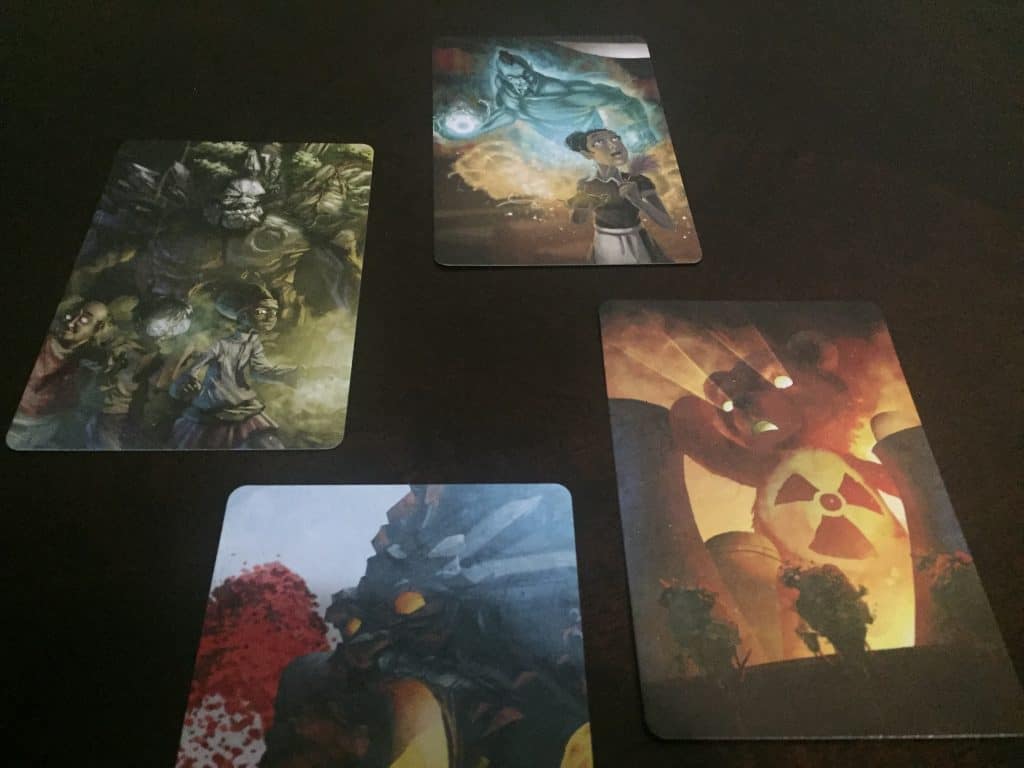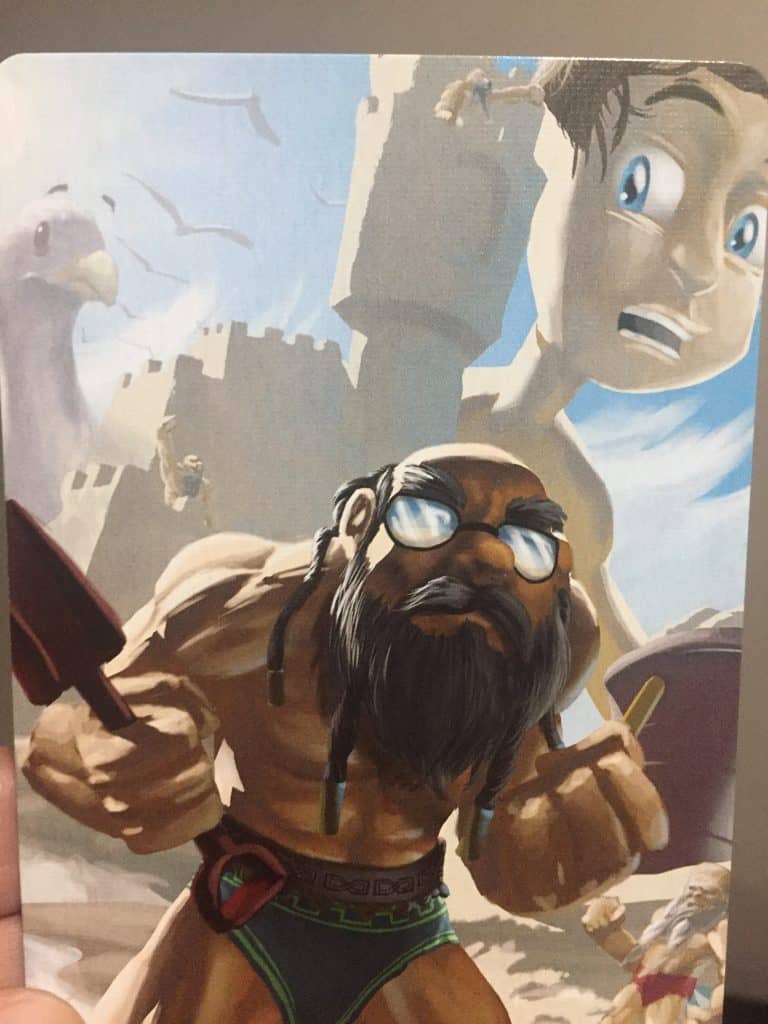Muse is a party game for 2 to 12 players, designed by Jordan Sorenson and published by Quick Simple Fun Games. Original art contributed by Apoline Etienne, Andre Garcia, and Kristen Plescow
In 2008, Dixit began what I like to call the “beautiful Rorschach” movement in board games. The secret sauce of Dixit’s mega-success lied not only in the amazing art, but also in that the art intentionally evoked and encouraged multiple interpretations. The cards were, in a sense, lovely ink blots that offered interesting windows into what you saw and how you thought.
Mysterium (not even going to try to type the Polish name because I will probably screw it up!) moved the “beautiful Rorschach” ball forward. It turned the relatively simple Dixit formula into a fully cooperative game with discreet phases, goals, and ultimately, a heavier ruleset as a result.
Muse also lives in this genre of games, but takes the “beautiful Rorscharch” idea in a different direction. Instead of adding layers of complication, Muse boils things down and presents what I believe to be the simplest ruleset possible. As a result, I feel that Muse is probably the most portable and party-friendly game in this genre.
Does Muse really rise above the pack? If you own and enjoy these other games, is Muse still worth a look?
How to play Muse
Overview:
Muse comes with 84 original art pieces on tarot-sized cards called Masterpiece cards. You also get a deck of 30 Inspiration cards – more on those below. Finally, Muse comes with two cards with the full rules of the game, one with the main rules [the rules fit on one card! how awesome is that!], and one with a fully cooperative variant for 2 or 3 players.

Gameplay:
Your group begins a game of Muse by splitting into even numbered teams. When it’s one team’s turn (we’ll call them Team A), that team chooses one person to play the Muse. Another team to Team A’s left (Team B) draws six Masterpiece cards and two Inspiration cards. Team B then chooses one Inspiration card and one Masterpiece card and gives them to the Muse on Team A.
The Muse reveals the Inspiration card, which sets the rule for what kind of communication the Muse must use to give a clue. It can tell the Muse to hum a melody, strike a pose, make a wordless noise, use only one three letter word, or lots of other silly things. The Muse gives a clue that (hopefully) matches the Masterpiece card in some way. Then, the Muse gives the Masterpiece card back to Team B.

Team B lays out the original Six Masterpiece cards so that Team A can try to guess which card matches the Muse clue. If Team A gets it right, they get to keep the card. If they fail, Team B gets the card. The first team to gain 5 Masterpiece cards wins the game.
Strategy:
The most strategic part of Muse comes when Team B chooses cards to give to the Team A Muse. In Dixit, you want some but not all players to get your clues. Here, however, if you are on Team B, you want to make it as hard as possible for Team A to guess the clue. That’s a much more competitive and tense style of play.
So, you might want to pair an Inspiration card that says “name a piece of furniture” with a Masterpiece that has absolutely no furniture on it. Team A might get really creative and get the clue anyway – for example, you hand the Muse a picture of a sunset. The Muse gives the clue “Ottoman” to their team, then they get it because one of the players loves the board game Ottoman Sunset. Team A got lucky with that one, but keep doing that and they’ll run out of good luck, eventually!
Another wrinkle to be aware of is this: while you know what’s on the other picture cards, the other team’s Muse does not! So, you could hand off that Inspiration/ Masterpiece card pair hoping that the Muse says “cat” (three letter word). Meanwhile, you know that there are two other cards that show cats in the six card draw. In essence, you’ve laid a delicious trap for Team A. Laying traps, setting red herrings, etc., represent the best of what Muse has to offer in terms of strategy.

2-3 Player/ Cooperative Variant:
(I wish this was called simply the “cooperative variant,” rather than the 2-3 player variant. A family with young children, or a really chill game group of 4+ people that don’t want to play in teams, could feasibly play with this variant and not skip a beat).
In this mode of play, you get rid of the “trap” part of the game entirely and focus on clue giving. Each player will alternate playing the Muse. A Muse draws one Masterpiece card and two Inspiration cards and delivers their clue of choice. After that, they draw five more Masterpiece cards for players to consider.
The group wins if they get five correct guesses before three wrong guesses. Or you could just play until whenever, which is what usually happens in these types of games.
What I liked about Muse
1) A much more tense and competitive spin on Dixit that’s still really, really fun.
As I mentioned above, Muse challenges players to adopt a much more competitive mindset than Dixit does. Dixit ultimately creates a meditative, cerebral, and dreamy mood (at least for many of us). Muse, however, encourages players to lay traps, establish red herring clues, and stretch your opponents’ capacity for metaphor and association to their limits. If someone falls into your trap, or if you overcome another team’s attempts at misdirection, those are very satisfying moments from a gameplay perspective.
Further, Muse encouraged this spirit of competitive in a way that’s still silly and retains a party vibe. Your group might contain its share of very competitive people, but everyone is still striking poses, humming songs, and doing all sorts of other silly party stuff that is sure to bring the laughter and enjoyment.

2) Beautiful card art that matches what Muse is trying to do, rather than simply recreating the Dixit vibe.
Going along with the more direct and competitive vibe of Muse, some of the card art evoked that sense as well. I don’t recall seeing any radioactive apocalypse bears or aggressive looking genies in my tours through Dixit. My play group especially appreciated a dashing fellow that we dubbed the Hammerin’ Hasidim!


To be sure, you could easily use Dixit cards in Muse and vice versa. The art isn’t THAT different. However, I appreciated that Muse knew what it was going for and made efforts to craft an art style to match.
3) Extremely portable, in more ways than one.
Muse is one of those games that does not need a box at all. You could easily put the cards in baggies and take it to a Meetup, convention, bar, or any other similar setting. Normally, that’s not such a huge deal. However, party games get extra points from me if I can take them absolutely anywhere.
Further, the simple ruleset means that I could play Muse with all sorts of folks. I love Dixit, but good luck playing that with a group that has had a few adult beverages. Muse, however, finds a way to challenge players to be subtle and slick, but in a way that can survive a few rounds. I’ve had fun playing this with children, older folks… I can’t say enough about the range of Muse’s potential audience.
4) Cooperative mode, while not as good as the main game, still works.
By removing the competitive element and just making the game about clue giving and guessing, you remove a lot of what makes Muse really stand out among similar games. However, that doesn’t make the game bad. You can still have a ton of fun this way, depending on your group. And, like I said above, you might need to play this way if, say, you want to involve children, or folks who just want to enjoy a more serene time.
What I did not like about Muse
1) Not Enough Inspiration Cards
While the game doesn’t happen without the lovely Masterpiece cards, the mechanical core of Muse lies in the Inspiration cards. In one game of Muse, you’ll go through over half of the deck, if not all of it. I realize the secret to replayability lies in the different combinations of Masterpiece and Inspiration cards you could make. However, seeing the same Inspiration cards over and over again felt a little lame. Why is there only one Inspiration card that calls for physical movement (the “strike a pose” card)? You could do TONS with that kind of clue! I realize I could put that in there myself, but I’d rather have that in the game so that I didn’t have to explain to my game groups that I was making stuff up.
Really, that’s my only complaint. When my only real complaint about a game is that I want more of it, that’s a really good sign!
Who is Muse for?
Muse isn’t just a reiteration of Dixit. It takes what I call the “beautiful Rorschach” model that Dixit invented and delivers a spin that offers a different, yet no less satisfying, experience. Muse challenges you to be competitive, deceptive, and creative, all at once. Further, it does so in a package that’s highly portable and easy to share with a wide group of people. Muse will be staying in my collection and will come with me to any gaming Meetup I attend. I love this game.





Show Comments